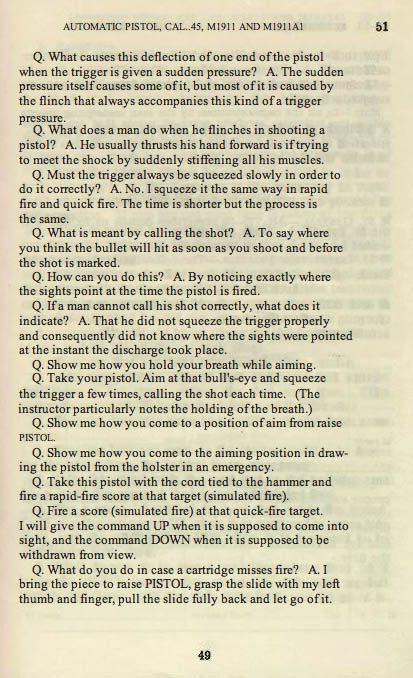AUTOMATIC PISTOL, CAL..45, M1911 AND M1911A1 Q. What causes this deflection of one end of the pistol when the trigger is given a sudden pressure? A. The sudden pressure itself causes some of it, but most of it is caused by the flinch that always accompanies this kind of a trigger pressure. Q. What does a man do when he flinches in shooting a pistol? A. He usually thrusts his hand forward is if trying to meet the shock by suddenly stiffening all his muscles. Q. Must the trigger always be squeezed slowly in order to do it correctly? A. No. I squeeze it the same way in rapid fire and quick fire. The time is shorter but the process is the same. Q. What is meant by calling the shot? A. To say where you think the bullet will hit as soon as you shoot and before the shot is marked. Q. How can you do this? A. By noticing exactly where the sights point at the time the pistol is fired. Q. If a man cannot call his shot correctly, what does it indicate? A. That he did not squeeze the trigger properly and consequently did not know where the sights were pointed at the instant the discharge took place. Q. Show me how you hold your breath while aiming. Q. Take your pistol. Aim at that bull’s-eye and squeeze the trigger a few times, calling the shot each time. (The instructor particularly notes the holding of the breath.) Q. Show me how you come to a position of aim from raise PISTOL. Q. Show me how you come to the aiming position in draw- ing the pistol from the holster in an emergency. Q. Take this pistol with the cord tied to the hammer and fire a rapid-fire score at that target (simulated fire). Q. Fire a score (simulated fire) at that quick-fire target. I will give the command UP when it is supposed to come into sight, and the command DOWN when it is supposed to be withdrawn from view. Q. What do you do in case a cartridge misses fire? A. I bring the piece to raise PISTOL, grasp the slide with my left thumb and finger, pull the slide fully back and let go of it.


Comments, suggestions, contributions? Let me know